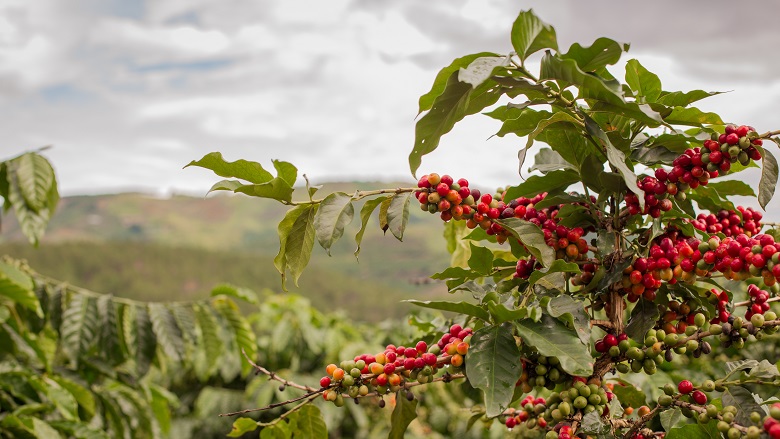Igh-Berkaana, the Cradle of Coffee (/iɣ bɛr.'ka:.na/)
While our violent past may be shrouded in mystery by the sands of time, our present is no less mystifying. In the darker days of our ancestors' lives, blood and labor would be spent in defense of key iron mines, forests for timber, and of course fertile land. Now, though, a frontier fortress is just as likely to be built overlooking orchards and plantations for cash crops. As I write this entry over my cup of coffee, I am tasked with considering how my master can mobilize his troops, not towards the defense or seizure of a military objective but to pressure the local leadership into limiting the number of other buyers with whom they do business.Igh-Berkaana ("Black Settlement") is a sizable, thoroughly fortified trade post in the highlands of Near Takhet, bordering Takhet Alay (the Takhet Mountains). The trade post's namesake is its premier export: coffee (kahweh) beans, which have long been at the center of the livelihoods of Igh-Berkaana's residents. The stuff was also dubbed "black gold" by explorers from the Haifatneh region who discovered the immense economic potential of coffee in light of the redevelopment of urban centers—and, by extension, the employment of busy bureaucrats, scholars, and other specialists in need of an occasional energy boost to get through the day.- Salaman in-Zuugal, trade liaison for a merchant prince
of the Haifatnehti city-state of Kailrana, 4075 HE
History
Igh-Berkaana's founding likely predates written history, but for much of its existence it was a small, isolated, largely peaceful village whose people lived simple lives yet being energetically eager to discuss everything from the politics of the outside world to the fundamental nature of the human experience, whether with rare visitors or among themselves during their daily labors. It is probable that the locally domesticated coffee there was to thank for the villagers' reputation for exceptional chattiness, even if the earliest coffee grinding and brewing methods weren't particularly refined so early in history. During the empire-building days of the Ancient Era, it seems that the villagers of Igh-Berkaana were quite content to live in relative isolation, as coffee could do little to defend them against force of arms, though occasional visitors were welcome as new conversation partners. During the bedlam of the early Grim Era that followed the Crusade and the Resistance, Igh-Berkaana drew little attention from Takheti warlords who mainly sought out more practical means of gaining a competitive edge over their rivals. If anything, what opened up Igh-Berkaana to the larger world was the power vacuum left by the collapse of Great Wahaareh in the aftermath of its leader's ambitious yet distastrous assault upon Andaen. The collapse of Great Wahaareh was followed by a civil war that left the realm's former holdings contested among its former generals and tribal chieftains-turned-warlords. Although the ensuing political and military violence calmed over the centuries, Vast Takhet remained fragmented when explorers and representatives of Haifatnehti city-states arrived there seeking business opportunities, new allies, or opportunities to establish spheres of influence. Extensive contact between the polities of the Haifatneh Basin and those of Takhet enabled Haifah visitors to discover coffee-growing communities such as Igh-Berkaana, and Haifah merchants soon saw the business potential therein. The now-fortified, considerably larger town of Igh-Berkaana is the product of such entrepreurship, at once Takhet's most productive exporter of coffee and sufficiently well defended to fend off bandits who would attempt to steal its produce for second-hand sale. Though Igh-Berkaana is directly under the jurisdiction of Tel-Adragar ("Adragar Stronghold," a warlord-led petty state in Near Takhet), Tel-Adragar itself has been largely subservient to the interests of Haifatnehti merchant princes for the last century, with these merchant princes funding the majority of Tel-Adragar's defense in exchange for largely exclusive trading rights. Struggles for hegemony over Tel-Adragar have mainly been fought not in the field battle but in the courts of Andaen or other Haifatnehti city-states, though it was also the site of a bloody crack-down during the so-called Great Takheti Coffee Coup. Despite the town's humble origins, Igh-Berkaana is essentially the crown jewel of a protectorate of Andaen.Demography and Economic Activity
The centrality of coffee agriculture to the local economy makes the demographic makeup of Igh-Berkaana seasonally variable, with the population nearly doubling from the middle of the off-season to the peak planting and harvesting periods. The itinerant workers in Igh-Berkaana were once predominantly young people from nomadic clans dwelling in the highlands of Near Takhet, but these days, the majority are underemployed sailors and porters from coastal Takhet, the Haifatneh Sea, and sometimes farther afield. Igh-Berkaana is thus a rather diverse town for its size; eateries and shrines cater to visitors from a range of different cultural backgrounds. (In respect to laborers from Andaen, locals refer jokingly refer to the town's few taverns as Andaeni temples.) For a month or so after the travel season, a number of laborers linger to practice their traditional handcrafts, hoping to find buyers who see their goods as sufficiently exotic to be worth paying healthy dividends for. The remainder of Igh-Berkaana's populace consists of subsistence farmers, tradespeople, petty merchants, and the like. Tthe town has a notably small number of subsistence farmers proportionate to the overall population, as arable land is limited in the highlands in general, never mind where coffee plantation owners have seized control of much of that land over time. Thankfully, the revenues from coffee exports are such that, barring an economic disaster, the town's leadership can import the majority of the town's foodstuff as well as raw materials and tools.Population
~12,000 off-season
~14,500 during the coffee growing season
~19,000 during the coffee planting and harvesting periods



Comments